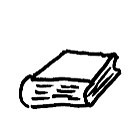
Doorstopper Novel
With this post, we move into the realm of beliefs about your product: The STORY
First of all, many beginning writers I know believe they must write at least a novel. A real book. Something “big”. And a series is even better! Yes, even with stories, size seems to matter in a certain way.
For a while, especially in Fantasy, bigger was better, no questions asked. If not the single book, then the series. It had to be huge. Doorstoppers, at least three for a series, but five were better. Maybe even ten, or a dozen. Imagine the size of that world, the headcount of the cast and the number of subplots to fill that many pages… it’s daunting!
Bigger is better!
And then you have the other extreme: Short stories.
There isn’t a clear definition of length for short stories by word count – officially – but lengths of 2,000 to 7,500 words are commonly mentioned. It “should be readable in one sitting” is an informal definition. However, many, many magazines have word count limits for the short stories they accept, and those limits have gone down considerably in the last 20 years. I’ve seen several go below the 2,000 words that were the lower limit of actual short stories.
Flash fiction has become popular, including the “drabble” (100 words) or even “Twit Fic”, confined to the 140 characters that Twitter allows. That’s about 23 words, btw. And I have seen stories told in such few words.
Shortest is best!
So how do we know?
It can be a fun challenge to write a story to word count. It forces you to really think about the moment, the character and what happens – and how to tell it in a way that fits the word count.
Here form determines the shape of the story.
But you can also let the story determine the form.
The story is the story.
And this is the actual solution: A story should be just as long as it needs to be. Tell the story. That’s all. Make it clean, to the point, let it carry a punch. Focus on good story telling, not on length.
And the beauty of this?
It’s entirely possible in the new world of publishing. Ebooks can be any length at all! You just have to tell your readers what to expect.
So let go of that belief your story has to be a novel, or else! If you give yourself permission to simply tell the story, and to determine what to call it once your finished, your writing will be less constrained. You will worry less about form, and you can focus on what’s actually going on with your characters.
And … you might be surprised by your writing brain. It has been trained on what you have been reading, so it might just give you the size you dream of – unless you try to force it.
Here’s some tapping to get you out of the size trap:
Even though I always thought I had to write a novel, just to be a full-fledged author, I’m totally okay the way I am, and I now give myself permission to simply write the story.
Even though I thought only novels actually sell, I’m a good writer, and I now give myself permission to let the story flow and see what happens.
Even though I’ve always dreamed of writing a wonderful, full novel, I’m okay the way I am, and I now choose to let my story flow and work out the formal parts after I’m done with that.
Your Turn:
What’s your preferred story size to read?
Which size are you comfortable with when writing?
What happened while you were tapping?
And finally – what are you creating right now?
Would love to hear from you!
Image Source: F. Moebius
PS: You’ll find my personal experiences with these beliefs in the comment section. Because I am tapping with these very sentences, I’m inviting you to join me on this journey, and share your experiences.
PPS: My newsletter contains a full tapping round to go with my blog posts, so it’ll be easier for you to get results. Sign up through the form on the upper right hand corner, and receive that tapping round plus occasional special offers. If you’re on a mobile and can’t see the sidebar, you can sign up through this link: Newsletter Sign-up.
